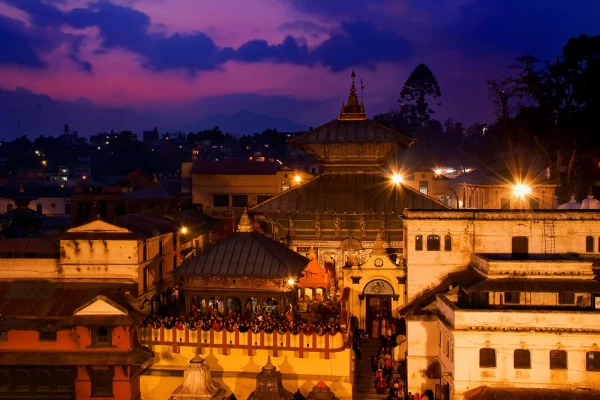Pashupatinath Darshan: Spiritual Journey to Nepal

The right way to offer prayers at the Pashupatinath Temple
The Pashupatinath temple as well as the ‘Pashupat Chhetra’- or the area stretching around the Pashupatinath Temple - is a center of faith and devotion for all followers of Hinduism around the globe.
The Pashupat Chhetra is constituted by a 264-hectare area around Dev Pataan, Jayabageshowri, Gaurighat, Chabahil, Kutmahal, Gaushala, Siphal, Pingalasthan, and the Sleshmantak Forest; encompassing around 492 temples, sprouts, shrines, etc. of various architectural origins and over 1,000 Shiva Lingas.
This area has been called ‘Pashupat Chhetra’ since the Lichhavi era and is home to various sculptures that date back to about 300 B.C. It is the oldest of all religious places in the Kathmandu Valley, making it an open museum of ancient artwork, sculptures, and shrines.
During the daily prayer offerings to Lord Pashupatinath, worship of Shaligram and Shakti also takes place. Similarly, each year, the Budhha Mukut is placed on Lord Pashupatinath. The priest Narayan Prasad Poudel says that all of these together make Lord Pashupatinath the example of religious union. The world heritage site Pashupatinath attracts followers of Hindusim from all around the world in large numbers.
Pashupatinath Darshan
You might have visited Pashupatinath numerous times. Some of you might be planning to visit, but might be unsure about the right procedure to follow. According to the priest Narayan Prasad Poudel, the first thing you need to do is to take a bath and arrive at Pashupatinath with a clean body and clean clothes. Next, you have to leave your slippers/shoes outside and after passing through the security checkpoint, enter the Pashupatinath premises from the west entrance.

The west entrance encloses a Temple to worship the Guru, which is only open on Guru Purnima. First, prayers must be offered at this temple and only then one must enter inside. The main Bhattas (Priests) of Pashupatinath also offer prayers at the Guru’s temple before entering the inside. After that, the sculptures of Lord Ganesh and Skanda Kumar are to be worshipped. Then, the Shankaracharya Shrine is worshipped. Offerings of Laddu (A kind of sweet) and Dubo( A kind of grass) are made to Lord Ganesh.
Only after worshipping Changunarayan Temple and the Rudrakaareshwor temple, is one supposed to worship the West entrance of Pashupatinath. Following that, we should offer prayers to Lord Hanuman and Nateshwor respectively. After that, Lord Shiva’s Trishul and Goddess Annapurna should be worshipped.
Then, Chandeshwori, the Sun, Red Lord Ganesh and Basuki should be offered prayers respectively. On worshipping the Baasuki Snake; Mustard seeds, Barley, Curd, Milk, and Honey should be offered. The Basuki Snake’s grand puja is conducted with offerings ranging from 1,100 to Crores of rupees. The devotees who do not wish to host the grand puja may offer smooth Bel Leaves to the Priest.

After the worship of Basuki, the Budhanlkantha on its right and left should be worshipped. Lord Bishnu should be worshipped with Barley and Mustard seeds. Then, the turn for the worship of the east entrance arrives, and simultaneously of Bhrangi and Astha Chiranjivis. The Bagmati River, on whose banks the entire Pashupat Chhetra lies, should then be worshipped. Then, Striyanta and Santanbhareshwor should be offered prayers. This hectic trip finally earns you a break at this point.
Once you reinvigorate your body and spirit, you move on to your next spot – The lord Krishna Temple. At this point, you may break a coconut; this is the only place within the Pashupatinath Premises where you’re allowed to do so. After this, you make a trip to the Bhairav and then to the Shahsra Linga where you offer Bel leaves, Barley, Curd, Milk, Ghee, and Honey.
Nandishwor Hanuman and Nandi are next on your list, after which you do a series of interesting activities. You first take a peek of the main Pashupatinath temple from the south entrance, and move east and take another peek and then take the south toward the east entrance. Then, you worship the Tatpurush and take the right towards the west side.
Now, after worshipping Baamdev at the North side, you walk down the steps and offer prayers to Lord Pashupatinath from outside the east entrance itself without stepping up the stairs. Then comes the most important bit – Lord Bishnu should be offered prayers while remembering Lord Shiva, then Gajur should be worshipped thinking about the live form of Lord Shiva. On doing this much, the prayers and puja within the Pashupatinath premises are said to be complete.
Especially on full moons and on Shivaratri, this process is believed to grant a lot of blessings. On full moon days, performing worships from dawn till dusk is believed to create a live presence of Lord Shiva himself.
If not doing grand pujas, flowers and unbroken bel leaves can be taken to Basuki and Pashupatinath which shall be administered to the temples by the assistants of the priests. However, only the main priest is allowed to enter the main temple of Pashupatinath for worship. No matter how grand of the puja is being conducted, devotees are to worship Lord Pashupatinath from outside.
A special worship ceremony is conducted from 5:30 to 8 P.M. every evening at Pashupatinath. This is also done by the Bhattas ( Priests) there. During this time, all four entrances of the temple are opened. During the month of Poush, this ceremony is administered during night time, which eventually ends only at dawn.
For Darshan & Holidays Package Email Us : [email protected]
